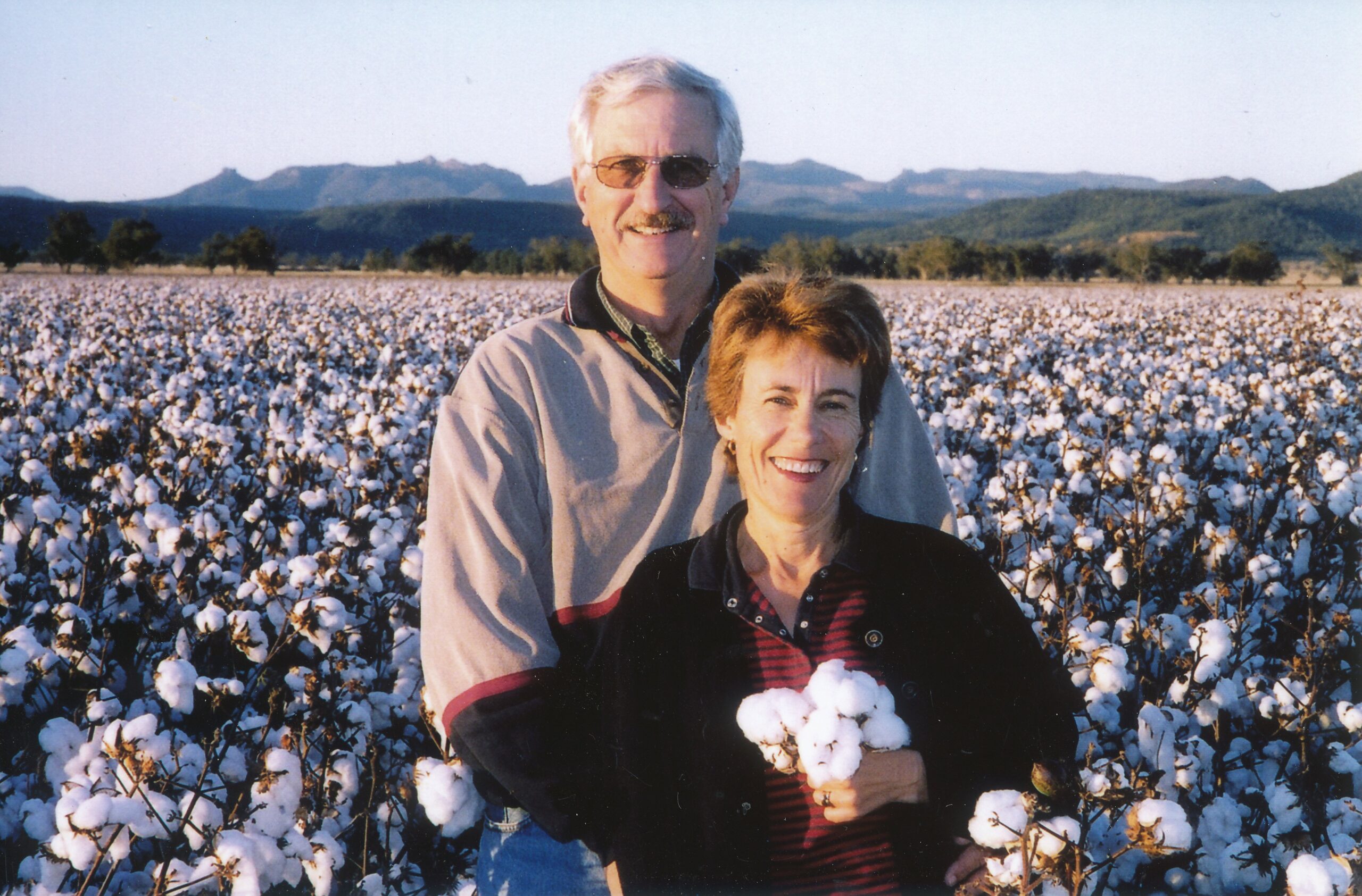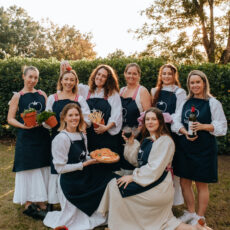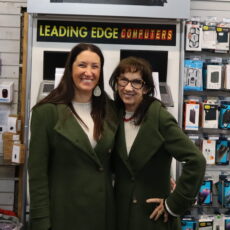Narrabri residents Jack and Jacqui Warnock have been busy packing up their home and belongings with mixed emotions as they farewell friends and associates across the district.
Mr Warnock has spent more than five decades involved in the cotton industry, starting off as an agronomist and technical advisor to later building a farming enterprise at the couple’s property ‘Warilea’ where they raised their four children, Brendon, Adam, Elizabeth and Julia.
Mr and Mrs Warnock are moving to Sydney for retirement from the farming industry and to be closer to their youngest grandchildren.
The Courier’s social correspondent Liz Campbell has prepared the following questions.
Jacqui, where did you both meet for the first time?
Jack and I met in 1973 at a woolshed dance at ‘Ventura’ Edgeroi whilst Jack was employed as the agronomist with Auscott and I was teaching at Moree High School. We were married in 1975 and I began teaching at Narrabri High School when Betty Berriman was principal. Students from those early days still contact me and through the years I have enjoyed supporting the schools through my connection with the Narrabri Eisteddfod, the Raise mentoring program and bush poetry.
The farm has been a part of your life for many years. How do you feel the lifestyle of country living has influenced your children’s upbringing?
We have been farming at ‘Warilea’ for more than 38 years, so it has been a big part of our children’s lives. They have had space to live and grow, appreciating the wide-open spaces, riding bikes and finding places to swim. Over the years they have loved having friends to visit and share the farm and country life with them. Being part of our family farming business, they have grown up knowing the value of hard work and long hours, appreciating the vagaries of the weather, be it drought, rain at harvest time, the disappointment that comes after a hailstorm – and I think all this makes them appreciate that life is sometimes beyond our control. But you have to keep going and look to the future. All our children have participated in work on the farm, and it is gratifying to see their capabilities and satisfaction with a job well done. Brendon, continuing here at ‘Warilea’, keeps the connection with all that we have managed to achieve on the farm and its productivity. While our home will no longer be here, I think there will be the feeling of “going home to Narrabri” in our Sydney-based family for quite a while, and with Brendon, Bec and children staying on we will all have a reason to return, often.
Jack, agricultural procedures have changed vastly over the past few decades. Can you tell us a little bit about how your family has been involved in these changes?
I arrived in Narrabri as a young agronomist in May 1972 with a position at Auscott Limited, after working for the Department of Agriculture as an agronomist-in-training at Trangie and Leeton. In those first few months of employment, I was responsible for allocating empty cotton trailers to the crews of two-row International cotton pickers. Picked cotton was unloaded from the picker basket into the trailers at the end of the field. Several men would spread the seed cotton in the trailer and ‘stomp’ the cotton to maximise the amount of seed cotton in the trailer. Full trailers were assembled and hauled to the gin yard to await the opportunity to be ginned. When all the trailers were full, cotton picking had to stop until empty trailers were again available. Contrast this to the picking of our final cotton crop on ‘Warilea’ in April 2022. Having taken delivery of a new third generation John Deere CP770 six-row round bailer cotton picker, it was gratifying to see its efficiency, cleanly picking and baling the cotton. The contrast between the 1972 and the 2022 cotton picking could not have been greater, from cotton trailers to round bales, two-row picking to six-row picking. Add to that the improvement in yield, a 300 per cent improvement in those 50 years, and it’s clear that we have witnessed tremendous advances in half a century. In the 1972-73 season we were also battling insect resistance in such a way that too much chemical was being used to little advantage and the method was unsustainable. Thanks to our research scientists at the Cotton Research Centre in Narrabri there have been tremendous advancements in integrated pest management, and ultimately some thirty years ago the development of transgenic cotton varieties that provided dramatic improvements in insect and pest management, and a more than 95 per cent cut in the use of insecticides over those years. Throughout this time, plant and equipment has improved in efficiency, with the most dramatic improvements resulting from GPS and satellite guidance systems. The development of irrigation infrastructure, including the construction of irrigation bores, was central to my education and I have had great satisfaction working with Jim Purcell. His engineering skills have allowed us to carry out developments of pumping stations, channels and drains, pipelines, culverts and on-farm storages. Over the past several years our son Brendon, with assistance from consultants Steve and Anna Madden and Pioneer representative Sam Gall, has introduced maize (or corn) into our rotation program to help manage plant diseases such as verticillium wilt. This has been a very satisfying development. Fifty years ago, I was involved in trials of maize varieties at Leeton when ‘dwarf’ varieties were favoured. Today the preferred varieties grow to three metres tall, producing crops yielding 18 plus tonnes per hectare and it has been a majestic sight with our Nandewar mountains back drop. The move into high yielding summer grains such as maize and further focus on winter crops such as wheat, legumes, canola and pulses has led us to develop a silo complex where high moisture grains can be harvested earlier and dried in these silos using a process called ‘natural air drying’. The monitoring and control systems have been provided by Canadian company OPI Blue Grain Management. I feel proud to have been involved with the research based evaluations and development, welcoming researchers onto our farm. One project we enjoyed being involved in was the monitoring of beneficial insects and birds on our farms following an extensive tree planting project. We have been involved in producing ‘pure seed’ cotton planting seed for many years and this has provided us with an opportunity to evaluate and embrace new varieties as they become available through the Cotton Seed Distributors program. We have always embraced new technologies for monitoring soil moisture and scheduling irrigations. In 1980 I was one of the first agronomists to utilise neutron probes for monitoring soil moisture. Later, we embraced improved technology which allowed us to receive data from in-field soil moisture probes. This data was available to our son Brendon and farm staff to allow efficient use of our extremely valuable irrigation water. We are most grateful for the people in the
excellent services sector that supports the cotton industry here in Narrabri and for the many employees who have worked along with us over the years, especially Geoff and Tracey Page who have been with us since soon after we started farming in 1984.
Jacqui, you have both contributed to the community and become tremendously involved in voluntary organisations, can you name a few of these?
Living in Narrabri has given us both many opportunities to engage with the community. As the children were growing up, we did all the parent things, swimming club, Little Athletics, P&C committees, soccer, netball, cubs, ballet and drama. In later years it has been Meals on Wheels, the Eisteddfod and bush poetry entertaining. The Aero Club in Narrabri gave our son Adam the opportunity to pursue his love of flying. He gained much flying experience here with Kaputar Aviation and now is a flight captain with Qantas. Also, my involvement singing with Harmony Inc, the talented Julie Fawcett and all the singers I have had the pleasure of learning from and performing with, have been just delightful. One of our favourite groups though would have to be the Narrabri Bush Walking Club. There is nothing like a day spent out really exerting oneself in the magnificent Nandewar Range, hiking with like-minded people to places one can only reach on foot. That has been an outstanding feature of living in Narrabri and our membership of the club continued for the last 30 years. Whilst we are looking forward to exploring new areas closer to Sydney, we will be drawn back to the views from Mount Kaputar, I’m sure.
You have been greatly involved in farming industry related organisations Jack, how has that been for you?
I have undertaken many voluntary positions on farming industry and community groups including Cotton Australia and Namoi Cotton boards, Water Users Association, Cotton Growers Association, Namoi Water, Catchment Management Authority, the Santos Gas Project Community Consultative Committee, the Gas Project Water Technical Advisory Group, the GISERA RRAC (Gas Industry Social and Environmental Research Alliance Regional Research Advisory Committee) and the Maules Creek Coal Community Consultative Committee. It has been tremendously gratifying to have been able to contribute my time and efforts to these groups and to have worked alongside such inspiring people.
Can you tell me a little about your involvement with the Eisteddfod Jacqui?
What a terrific time I have had being part of the excellent community event which is the Narrabri Eisteddfod. I have been involved every year since it began in 1997 when Elizabeth and Julia were performing. Since then, I too have competed and now it’s our grandchildren up on stage. As well as fulfilling many committee positions, I have been fortunate to have been president of the Narrabri Eisteddfod for nine years. I received two pieces of feedback this year, both relating to how well students have done in their school life – partly, their parents said, because of the confidence they gained through participating in the Eisteddfod. One student has gone on to become school captain with excellent public speaking skills and another has more confidently transitioned into boarding school life and studies. It has been hugely gratifying to work along with many excellent volunteers, especially Janet Paas and Kara
Taylor, to bring the Eisteddfod to fruition each year.
The friendships you have made, both through these organisations and on a personal level, have been a focal part of your years here.
Narrabri is certainly a very friendly town and we have been very fortunate to grow beautiful friendships. Our daughters Elizabeth and Julia will always treasure their circle of friends from primary and high school here, even though they have gone on to careers in teaching and graphic design based in Sydney. One lovely group I’ve been involved in is the Bethungra Belles, named after the home of its founder Georgie Murray. We first came together in 1994 when we were mothers with young children. Apart from the physical activities of tennis, walking, yoga and pilates, we are a group of ladies and sometimes our partners too, who meet socially and support each other. Even though some members have since departed Narrabri, our bond is strong, and we maintain contact and interest in each other’s lives, so I’m looking forward to this continuing connection.
What are the most quintessential aspects of living in the Narrabri district that you will take away with you?
The people. You can’t live in a town the size of Narrabri for so long and be involved with many organisations to not know a wide a variety of people from all aspects of life. There are so many connections, from the teachers at Narrabri Primary School who taught our children to the ones I taught when they were in high school, and those teachers at the West School who are now teaching our grandchildren. To be greeted in shops cheerfully and by name, the occasional conversations in the street which are uplifting and part of living in Narrabri, my hairdresser who was previously one of my students – I’ve loved all of it. To be known by shopkeepers and service people and to be able to relate so comfortably through a shared history. It is very special to see the educational progress in this town, to be involved with the young ones through the Education Foundation and to see the Southern Cross University campus here in Narrabri. And Mr Poetry – my friend Max Pringle and our involvement with the older people, residents and staff at Jessie Hunt and Robert Young, as well as Weeronga at Wee Waa. The Narrabri and Wee Waa Shows and the Drover’s Campfire at Boggabri are fond memories of shared community times and I’ve loved the bush poetry audiences Visions of waking to kangaroos on the lawn, often one with a joey in her pouch, king parrots swooping in to perch high in the trees, blue wrens flitting through the garden and pelicans and black swan to be found on the storage – I have to say it is nature’s blessings to have lived here. Add to this the bountiful roses we’ve enjoyed, and the mulberries, oranges, and apricots we’ve harvested over the years – there is much to treasure in home life lived here. Early morning or sunset walks, alone or with all the family together, around the storage under a big wide expanse of sky or admiring the enormity of a clear starry night are quintessentially Narrabri living.
Leaving Narrabri
by Jacqui Warnock
For almost fifty years I have lived near Narrabri
Because in my youth a country life was what I sought to try.
Romantic thought of life out west, school teaching at Moree,
Met Jack and moved to Narrabri, we raised a family.
So many years have come and gone with ‘Warilea” our home
But now retirement beckons and it’s time for us to roam.
We’re packing up a lifetime of endeavour that’s for sure,
A home that’s full of milestones, life’s memories that endure.
Our family who’ve grown up here, our visitors and friends,
But as my mum would often say, “Good things come to an end”.
So much of life in Narrabri we’ll carry in our hearts,
And very soon, exciting times, our next adventure starts.











